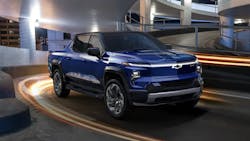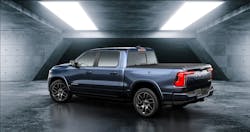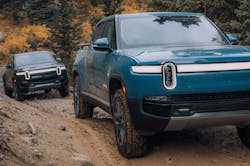ICE dominates pickups, but electrics proliferate
Higher interest rates, a slowdown in home building, continued component shortages, rising costs, and lessening demand tied to a wavering economy have builders of light commercial trucks, including pickups, doing a balancing act. Sales were down substantially from 2021: Ford is off 9.9% at the end of 2022; Ram is down 17.8%; and Chevrolet/GMC is off 1.8%, according to one analysis. The slump has continued into this year. The mission is now to supply vehicles at affordable prices, one executive at a major builder said. And those products are increasingly interesting.
Electric pickups from two major sources—General Motors and Ram—have moved closer to market, while others from Ford and Rivian increase sales and presence on streets and highways. But gasoline and diesel engines power the big bulk of pickup trucks now being built and sold, and will continue to for quite some time, according to industry observers and manufacturers themselves.
Read more: The Amazing Emissions RaceThe internal combustion engine, often referred to as ICE, seems to have a solid though limited future as the nation and the world make an accelerating shift toward cleaner sources of propulsion. Engineers continue to improve gasoline and diesel engines, making them more efficient and increasingly capable, and builders are investing millions of dollars to produce these better products.
“We are in a world in transition in terms of energy,” said Allen Schaeffer, executive director of the Diesel Technology Forum, which advocates continued use of modern ICEs. “We are reliant, heavily, on fossil fuel energy but also trying to make a move toward using more renewable energy. Both in the kind of energy that powers our homes and our vehicles, machines, and equipment, the internal combustion engine is seated squarely between these two worlds.”
Yet Clean Air authorities push for quick adoption of clean technologies, especially electric power. Many people say that electric utilities will never be able to supply enough power to charge all the batteries-on-wheels envisioned by government leaders. One answer is installation of solar-panel arrays to support electrification, and that is what is happening with several projects begun in California. Truck makers, meanwhile, are preparing EVs to meet the future.
Silverado EV
The upcoming Chevrolet Silverado EV is a departure from the current Silverado line, both in powertrain and in styling. The General Motors division prominently featured the truck at the recent NTEA Work Truck Week, outfitted in appropriately simple WT (work truck) trim. That’s how it will initially be sold, as a fleet-oriented truck, said Nick Rutkowske, product manager for full-size pickups. Fancier versions will appear later.
The Chevy EV’s high-tech, electric-drive mechanicals were greatly emphasized at the show and are enthusiastically described in on-line literature. Included are a healthy range of 400 miles with easy charging methods, and a strong power and torque rating: up to 754 horsepower and 785 lb.-ft. Its tow rating is 10,000 pounds, and motors on both axles make it sure-footed.
The Silverado EV sits on GM’s “skateboard” Ultium platform, with batteries and accompanying cooling apparatus beneath the floor and controls stashed away so considerable space is available inside the front trunk, or “frunk.” Design is reminiscent of the once-popular Chevy Avalanche, complete with an expanded C pillar and fold-down rear wall, allowing long loads to extend inside the cab.
Space under a hood has traditionally housed an internal combustion engine, either gasoline (sometimes converted to burn propane or natural gas) or diesel. “That’s where I spent my career,” Rutkowske said, what with all the attention given to electric trucks, “but I think I’ll be doing that for quite a while yet.” Like other builders, GM is far from finished with the ICE.
For instance, the Duramax diesel V8’s rating is up to 470 horsepower and 975 lb.-ft., not quite as high as but competitive with others’ diesels. The 6.6-liter Duramax continues to be optional in Heavy Duty 2500 and 3500 Silverado pickups, and the light-duty 1500 is now gasoline only. The 4-cylinder turbodiesel has been quietly dropped for lack of sales.
Ram 1500 REV
Also at Work Truck Week, the Ram division of Europe-based Stellantis highlighted its low-slung Revolution 1500 EV concept truck but pointed to the 1500 REV electric truck as the one that will see production sometime next year. It has a dual-motor, battery-electric powertrain and normal hood, cab, and bed. Front styling features caliper-shaped LED accent lights borrowed from the concept vehicle, said Mike Koval, Ram Brand’s CEO. Like other Rams, it also sports a massive front end, but has a frunk, not an ICE, behind it.
Koval also touted “electrification” and “leading edge technology” that is appearing in ICE-powered pickups and vans. Aside from its electric powertrain, the Revolution concept truck also uses environmentally friendly materials, such as “apple leather” on its seats and floors made of rubber and cork, and these might be used later in production trucks.
Stellantis has a Dare Forward program with the goal of full electrification of its North American and European automotive products by 2030, said Dave Sowers, head of Ram Commercial marketing. Fitting into that program is a current component, the eTorque mild-hybrid system. It uses an extra belt-driven alternator that sends power to on-board batteries for use during acceleration; the alternator then becomes a motor that adds boost to the engine. A Tradesman pickup with the system was displayed at the show.
For the work-truck market, Ram is expanding availability of its 1500 Tradesman model with the current DT chassis and cabs; previous Tradesman trucks, which have simpler interior trim and equipment, used an earlier DA chassis, Sowers said. Tradesman 1500s will come only with 4-door Quad and Club cabs, the most popular types, with 2-door Regular cabs available on certain Heavy Duty pickups and chassis-cab models.
Ford Pro
Last year, Ford’s marketing and publicity efforts were on its F-150 Lightning electric pickup, which has now been on the market a little more than a year. So far Ford has sold about 20,000 and expects to build about 150,000 this year. In February, it had to pause production due to a battery problem that is suspected of causing one fire in a parked Lightning; SK, the battery supplier, worked with Ford engineers to fix the problem and production was set to resume in mid-March.
Ford’s emphasis at this year’s Work Truck Week was on the Super Duty series, which was updated last fall, and the e-Transit van, which has been on the market for more than a year. Tim Baughman, general manager of the Ford Pro fleet support system begun with 2020-model trucks, talked about the program’s expansion. It has fielded 900 mobile service vans, with 2,100 to be in service by year’s end, all run out of dealer-operated Ford Pro Service Centers. Each has 24 or more large service bays to handle big, heavy trucks.
Read more: How predictive maintenance can save fleets a fortuneTelematics, a major component of Pro, can help fleet managers schedule work, oversee on-board product and tool inventories, monitor vehicle locations and driver behavior, and coach drivers to improve fuel economy, he said. A recently instituted Upfit Integration System of communications between Ford and body builders makes for faster and easier equipping of cab-chassis trucks for work by customers.
Rivian faces backlog
Founded in 2009, Rivian has had to work its way to the EV market while weathering persistent financial struggles. The company’s people labored through research and development and brought their R1T truck and R1S sport utility vehicle into production before the long-established automotive giants did. They are being assembled in a former Mitsubishi plant in Illinois, and Dagan Mishoulam, VP, Rivian Fleet, says it delivered more than 20,000 vehicles to American and Canadian customers in 2022. It now claims a healthy backlog of orders.
The R1T pickup is uniquely dimensioned between competitors’ mid-size and half-ton pickups. In addition to a short bed, the crewcab body has several lockable storage compartments including a frunk and central gear tunnel, with capacities totaling nearly 23 cubic feet. Its payload is 1,764 pounds, and it can tow as much as 11,000 pounds, Mishoulam said. Range is EPA-estimated at 328 miles and will eventually be as long as 400 miles. Rivian is setting up a network of Wayside quick chargers that use standard industry plug designs.
EVs are expensive to purchase, the company acknowledges. But lower operating and maintenance costs result in a break-even point at 50,000 to 75,000 miles, depending on what alternative ICE trucks would cost to buy and run. Commercial fleets are Rivian’s initial target market, and it is preparing R2-series “mass market” vehicles. Rivian had a deal with Amazon to build 100,000 e-delivery vans, but the retailer has taken fewer than expected and the two are negotiating to end the exclusive agreement.
How safe are electric pickup trucks?
Increasingly large and heavy full-size pickups and sport-utility vehicles have drawn the attention of consumer advocates and government officials. The Environmental Protection Agency said recently that new-vehicle weight and horsepower both hit records in 2021 with average vehicle weight hitting 4,289 pounds. Electric vehicles are heavier than their gasoline and diesel versions, and that has raised concerns.
In January, the head of the National Transportation Safety Board, Jennifer Homendy, warned of an increased risk of severe injury and death from collisions involving heavy electric vehicles. She pointed to the GMC Hummer EV that weighs over 9,000 pounds, up from about 6,000 pounds for the gasoline version, and the Ford F-150 Lightning, which at 6,500 pounds is 200 to 1,500 pounds heavier than gasoline-engine versions.
Read more: TMC spotlights alt-powertrain challenges and potentialGreater weight “has a significant impact on safety for all road users,” Homedy said in a speech to an insurance group. “We have to be careful that we aren’t also creating unintended consequences: more death on our roads.”
Size is another issue. A Consumer Reports analysis of industry data from 2000 to 2018 found passenger trucks to be 24 percent heavier, but also 11 percent higher. The result is increased danger. CR found that these big trucks have poorer front sightlines and bigger blind spots that can hide a pedestrian or smaller car right in front.
“Because of their height and long hoods, we found that some trucks had front blind spots 11 ft. longer than those in some sedans and 7 ft. longer than in many popular SUVs, which increases the risk of the driver running over someone in front of them that they cannot see,” said CR’s auto editor, Keith Barry.
The Insurance Institute for Highway Safety notes that the tall front ends of pickups line up with some rather vulnerable spots on bodies of pedestrians, including an adult’s hips and pelvis. Consumer Reports notes that smaller pedestrians are at further risk because their heads are at that same level. To counter such risks, manufacturers have fielded cameras and electronic sensors that warn drivers away from people and other objects in their path or alongside.
Technology conquers all?
Pickups have grown bigger because customers want more capability for transporting passengers, hauling cargo, and towing trailers, manufacturers have explained. Larger cabs can haul more people comfortably, and the rise in popularity of crew-cab pickups supports that contention. The desire to haul and tow more results in larger engines which need greater cooling capacity, and larger radiators require taller front ends. Greater body height comes partly from taller suspensions that provide more ground clearance while running off-road.
Blind spots are handled with greater use of cameras and warning devices that use radar and other sensors, say builders. Many of these devices are now standard on pickups because manufacturers are concerned about safety, and buyers, particularly fleet customers, want them. Meanwhile, bumpers on some large pickups have been lowered to make collisions with smaller vehicles, including cars, a more even match, CR has noted.
This article was originally published on ConstructionEquipment.com.
About the Author

Tom Berg
Tom Berg is widely acknowledged as one of the top truck writers in the industry. He has covered construction for more than 34 years and has test-driven well over 150 trucks for Construction Equipment.


